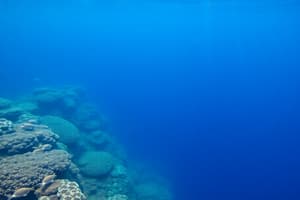Podcast
Questions and Answers
What is the photic zone?
What is the photic zone?
The photic is the uppermost layer of seawater lit by the sun.
What is the most accurate term for the feeding relationships among organisms living in the ocean?
What is the most accurate term for the feeding relationships among organisms living in the ocean?
Food web
What model describes who eats whom and shows that only 10% of the energy is transmitted from one level to the next?
What model describes who eats whom and shows that only 10% of the energy is transmitted from one level to the next?
Trophic pyramid
In which zone would phytoplankton such as diatoms be most productive with respect to photosynthesis?
In which zone would phytoplankton such as diatoms be most productive with respect to photosynthesis?
What is a heterotroph?
What is a heterotroph?
What is the main process of binding energy into carbohydrates on Earth?
What is the main process of binding energy into carbohydrates on Earth?
Define diffusion.
Define diffusion.
How do hydrothermal vent communities capture energy in the absence of sunlight?
How do hydrothermal vent communities capture energy in the absence of sunlight?
What unifies all life on Earth?
What unifies all life on Earth?
If something is living, what ability does it generally possess?
If something is living, what ability does it generally possess?
What happens on a cellular level to a marine fish placed in freshwater in terms of osmosis?
What happens on a cellular level to a marine fish placed in freshwater in terms of osmosis?
What type of environment describes a salmon migrating from the ocean to freshwater rivers?
What type of environment describes a salmon migrating from the ocean to freshwater rivers?
If there are 10,000 kg of primary producers, how much energy would be transferred to primary consumers?
If there are 10,000 kg of primary producers, how much energy would be transferred to primary consumers?
How would you describe the environment of a fish with an internal solute concentration of 18 ppt in ocean water at 32 ppt?
How would you describe the environment of a fish with an internal solute concentration of 18 ppt in ocean water at 32 ppt?
What term best describes copepods in terms of feeding relationships?
What term best describes copepods in terms of feeding relationships?
What term best describes phytoplankton and Archaeans in terms of feeding relationships?
What term best describes phytoplankton and Archaeans in terms of feeding relationships?
Flashcards are hidden until you start studying
Study Notes
Ocean Zones and Productivity
- Photic Zone: Upper layer of seawater with sunlight penetration.
- Euphotic Zone: Subsection of the photic zone, where most oceanic biological productivity occurs.
- Disphotic Zone: Below the euphotic zone, still receiving some light but not adequate for photosynthesis.
- Aphotic Zone: Permanently dark layer beneath the photic zone, extending to the ocean floor.
Ecosystem Dynamics
- Food Web: The network of feeding relationships among marine organisms.
- Trophic Pyramid: Model illustrating energy transfer in ecosystems, showing only 10% energy transmission from one level to the next.
Phytoplankton and Photosynthesis
- Phytoplankton Productivity: Most productive in the euphotic zone due to ample sunlight for photosynthesis.
- Autotrophs: Organisms like phytoplankton that create their own food through photosynthesis or chemosynthesis.
- Heterotrophs: Organisms (e.g., animals) that must consume other organisms for food.
Energy Conversion Processes
- Photosynthesis: Primary method for binding energy into carbohydrates.
- Chemosynthesis: Energy capture method for hydrothermal vent communities, converting inorganic molecules into glucose without sunlight.
Transport Mechanisms
- Diffusion: Movement of molecules from high to low concentration, driven by heat.
- Osmosis: Specific type of diffusion involving water movement through a semipermeable membrane.
- Active Transport: Movement of molecules from low to high concentration across a membrane, requiring energy.
Life Characteristics and Adaptations
- Carbon-Based Life: All life on Earth is fundamentally composed of carbon.
- Reproduction: Key characteristic distinguishing living from non-living things.
- Osmoregulation: In freshwater environments, marine fish swell due to water influx, as they are in a hypotonic environment. Conversely, salmon migrate from hypertonic ocean waters to hypotonic freshwater for spawning.
Energy Dynamics in Food Chains
- Primary Producers: If there are 10,000 kg of primary producers, 1,000 kg will be transferred to primary consumers and 100 kg to secondary consumers.
- Feeding Roles: Copepods are considered primary consumers as they feed on phytoplankton.
Environmental Context
- Solute Concentration: A fish with an internal concentration of 18 ppt in seawater (32 ppt) is hypotonic and experiences osmotic stress as it retains water to balance external solute levels.
Studying That Suits You
Use AI to generate personalized quizzes and flashcards to suit your learning preferences.




